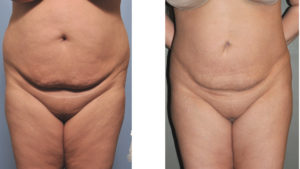
The concept of tumescent infiltration has been used in liposuction surgery for over 30 years. This is a fundamental component of all liposuction surgery. While the amount of fluid instilled varies by surgeon and is know by names such as wet and super wet, this fluid serves numerous functions such as pain relief, prevention of excessive bleeding, and to make the removal of fat easier. (hydrostatic gliding)
Tumescent solution contains numerous chemicals which cause various effects. One component is lidocaine. This chemical anesthetizes the skin, which allows the procedure to be performed while the patient is awake. If done under general anesthesia, lidocaine provides some short-term pain relief after surgery. Lidocaine is very safe if given in moderate dosages. Since lidocaine is broken down by the liver, it is important to make sure that one’s liver is functioning normally or that other medications being taken do not interfere with the liver’s pathway resulting in higher blood levels of lidocaine. This could result in a toxic dose of lidocaine during liposuction surgery. One unique and coincidental benefit of lidocaine is that it has a bacteriostaic effect which theoretically reduces the possibility of infection.Some of the medications that could potentially interact with lidocaine unfavorably include certain antidepressants such as Prozac and Zoloft, antibiotics such zithromax and ciprofloxan, thromax, and certain high blood pressure medicines such as inderol and procardia.
Another important ingredient of tumescence fluid is epinephrine. Epinephrine is the most critical component of tumescent solution because it helps control bleeding. Epinephrine causes blood vessels to shrink down, resulting in less bleeding during and after the procedure. Without epinephrine, the amount of bruising would be far greater and would take many weeks to months to completely go away. Coincidentally and fortuitously, it also decreases the absorption of lidocaine which helps prolong its anesthetic effects.
In many tumescent solutions, the addition of sodium bicarbonate is added to neutralize the compounded solution. This is important when the liposuction procedure is being done under local anesthesia to improve a patient’s comfort. Under general anesthesia, the use of sodium bicarbonate is really irrelevant, so it is not added when liposuction is done awake.
The use of a tumescent solution is an integral to the performance of liposuction as the use of a suction device or a cannula. It is a part of every liposuction procedure, regardless of the liposuction technique used.
Dr. Barry Eppley
Indianapolis, Indiana


